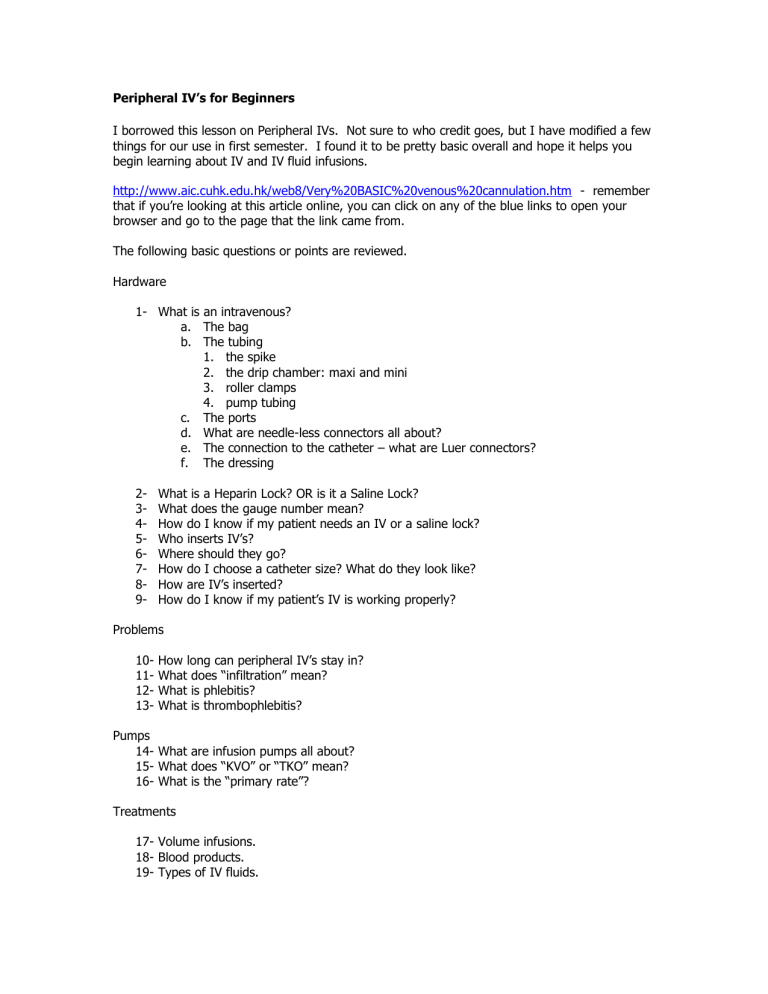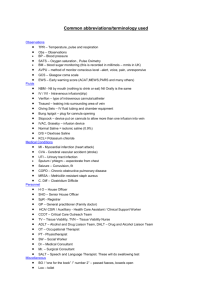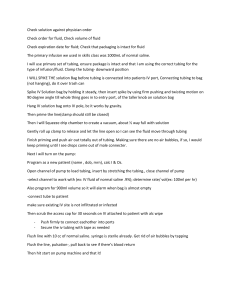
Peripheral IV’s for Beginners I borrowed this lesson on Peripheral IVs. Not sure to who credit goes, but I have modified a few things for our use in first semester. I found it to be pretty basic overall and hope it helps you begin learning about IV and IV fluid infusions. http://www.aic.cuhk.edu.hk/web8/Very%20BASIC%20venous%20cannulation.htm - remember that if you’re looking at this article online, you can click on any of the blue links to open your browser and go to the page that the link came from. The following basic questions or points are reviewed. Hardware 1- What is an intravenous? a. The bag b. The tubing 1. the spike 2. the drip chamber: maxi and mini 3. roller clamps 4. pump tubing c. The ports d. What are needle-less connectors all about? e. The connection to the catheter – what are Luer connectors? f. The dressing 23456789- What is a Heparin Lock? OR is it a Saline Lock? What does the gauge number mean? How do I know if my patient needs an IV or a saline lock? Who inserts IV’s? Where should they go? How do I choose a catheter size? What do they look like? How are IV’s inserted? How do I know if my patient’s IV is working properly? Problems 10111213- How long can peripheral IV’s stay in? What does “infiltration” mean? What is phlebitis? What is thrombophlebitis? Pumps 14- What are infusion pumps all about? 15- What does “KVO” or “TKO” mean? 16- What is the “primary rate”? Treatments 17- Volume infusions. 18- Blood products. 19- Types of IV fluids. 2 Peripheral IV’s for Beginners Hardware 1- What is an intravenous? Most people have some kind of idea what IV’s are about before they get to the hospital, but for first semester, a review of the basics is probably in order, since it’s pretty hard to imagine something more important to patient care. Let’s have a look: a. The bag Yup, that’s the bag. Looks like normal saline. Ok new grads, what’s “normal” about normal saline? What does “isotonic” mean? What other commonly used IV fluid is isotonic? This stuff that’s “clear as crystal” is commonly referred to as “crystalloid”. Sterile! The entire IV setup has to be EXTREMELY sterile: the bag, the tubing, the connectors, the catheter, the dressing… Why? b. The tubing The whole fluid path from the spike to the needle is sterile. 1. The spike This one’s vented – you use this kind with bottle mixes; it lets air get into the bottle, so the fluid can come out, while with bag mixes, the bag just collapses closed. 3 2. The drip chamber A little hard to see, but the one on the left is “maxi” drip, or ten drops per mL, and the one on the right is “mini” - 60 drops per mL. We never regulate constant infusions by eye anymore – most everything goes on an infusion pump nowadays. This is legislated in many States, California being one. But for a rapid IV volume bolus of something (not meds) – normal saline, Ringer’s lactate, whatever, we still use gravity. We will discuss in class how to regulate and use gravity/drip infusions. 3. Roller clamps We primarily use gravity tubing in two situations nowadays: for rapid IV bolus infusions, and for blood. For boluses, the roller clamp has two positions: “all the way open”, and “closed”. You will not be infusing blood in first semester. 4. Pump tubing Pump tubing is all different. The only thing to do is to learn the system where you’re at. One important thing that’s developed recently: ALL the sets have to self-clamp if they come out of the pump. In Sacramento, all our hospital systems use the ALARIS infusion pump. b. The ports 4 This is where things get plugged into the line. c. What are needle-less connectors all about? Needles or sharps are no longer used when accessing infusion systems. All ports are accessed using a needle-less connector site. d. The connection to the catheter: Luer connectors Not a bad picture of the end of the catheter. The tubing actually screws onto the yellow end there – except sometimes it’s blue, or green, or pink, or whatever, usually depending on the catheter size. But the screw technology is pretty uniform, all under the name of Luer connectors. That guy Luer – what a genius! 5 These syringes have female luer connections at the ends. The catheter hub of the IV, the hubs of injection needles, the connector hubs at the ends of IV tubing – they all use the same size and type of connector, which was probably what developing the Luer standard was all about. e. The dressing We like to be able to see the site (why?), so we put a clear tegaderm over it… Change the dressing if it gets loose, or dirty. 2- What is a heparin lock? Trick question! A peripheral IV that’s been capped and flushed with saline is still often called a “hep-lock” however we flush very few lines with heparin any more – dialysis catheters come to mind, and even they get flushed with ACD these days. More and more patients are being found sensitive to heparin. The current correct term is Saline Lock. This term denotes that the “lock” is flushed with saline. The “lock” is peripheral access without a full blown infusion. 3- How do I know if my patient needs an IV, or a saline-lock? It is important that any person admitted to the acute care hospital, or in the Emergency Department have IV access. The potential for an emergency is always present for a patient who is ill enough to be in the hospital. IV access affords us the most rapid ability to deliver lifesaving medications. The Standard of Care in our area is that a patient must have IV access unless specifically order that access is not needed by the physician. We will discuss this further in class. 4- Who inserts IV’s? Where should they go? 6 RNs insert. In practice, we stick to the arms for peripherals. Only very rarely will a patient get an IV in a foot – it’s risky for dislodging DVTs… Hands are good… Sites for children and infants vary greatly and can be almost any place on the body! 5- How do I choose a catheter size? What do they look like? What are you going to be running through the line? It’s pretty hard to run blood through a tiny little 22-gauge IV. An 18 is good for giving blood – once in a while a patient with really excellent veins will come up from the ER or the OR with a couple of 14’s in place. (14’s are BIG IV’s…) This is what I would call a 20 gauge straight angiocath… this is the one that we use for arterial lines, too. See the stylet in place, sticking out beyond the top of the catheter? 7 On top, the stylet in place – after insertion, the stylet comes out, leaving the soft, bendable catheter in the vessel. Then there are butterflies. For continuous infusions of crystalloid, intermittent meds, most situations, 20’s and 18’s are used. 6- How are IV’s inserted? In your 4th semester you will become IV certified, which means you will learn to place IVs and will place a given number on your own to show mastery. 7How do I know if my patient’s IV is working properly? Well… there are certain basics: for one, the catheter is supposed to be in the vein. How can you tell if the catheter is in the vein? Prior to using any Saline Lock, always flush per agency protocols. Monitor the site of any infusing IV site looking for signs such as swelling, pain or pumps that continually stop because they show an occlusion. Problems 8- How long can peripheral IV’s stay in? 8 Where we work, they’re supposed to stay in no longer than three to four days. If a peripheral site looks ok, and you’re stuck for other access, you might not want to pull it even if it’s older than it should be. Clarify the policy at your clinical site. Most of Sacramento currently is 96 hours or 4 days. 9- What does “infiltration” mean? An ugly picture that you do need to see… Sometimes the tip of the catheter pokes its way out of the vein into the surrounding tissue, and what’s going through the catheter goes into the tissue spaces instead of the vein where it was supposed to be. If the fluid is something isotonic, like normal saline or D5W, then this is usually not a big deal, and once you recognize the problem and stop the infusion, the fluid is rapidly absorbed by the tissues and the swelling goes away. What if the fluid is more dangerous or toxic? The trick of course is to recognize what’s happening – which is why checking your peripheral infusion sites is one of the first things you do in your assessment survey. That’s a pretty good one. Might’ve been something with K+ in it… Sorry about this one, but you do need to know – this might’ve been peripheral dopamine. If a vasoconstrictive drug gets into the tissues… this is why we use central lines for pressor drips. . 10- What is phlebitis? “Inflammed vein.”, right? The vein is becoming sore, and unhappy. If you see a red streak tracking upstream from an intravenous site, this is probably your problem. Your patient’s problem! 9 Can you see the reddening, heading north from the stick site? This IV needs to come out. Soon! But! What if this is your patient’s only IV? It still needs to come out. Get a new one in as soon as you can, then get this one the heck out. 11- What is thrombophlebitis? This is phlebitis, caused by a clot in the vessel. This is rather worse, and can obstruct flow back from the affected limb. PUMPS 12- What are infusion pumps all about? We use these all the time, and they’ve almost completely replaced gravity drips for everything. 10 This happens to be the kind we use – we hate them every time we get new ones – then we get used to them… then after a few years we get to hate some newer ones. They’ll try to tell you that change is good, but… Of course, the fluid is pumped towards the patient through whatever kind of tubing comes with the particular pump your institution bought. All of them need part of the tubing to sit inside the pump – this one has three little ball chambers in a row that sit in little openings, and is held in place with little prongs. You learn to use ‘em… There are many types of pumps. You will learn more in future semesters. This semester the focus is on learning how to initiate maintenance fluids. 13- What does “KVO” OR “TKO” mean? The pump will also holler at you if the line is blocked – is the IV tubing kinked? It’s worth remembering that it does take a certain amount of flow to “keep the vein open”, so that the blood vessel doesn’t clot itself off – lots of opinions about this, as usual, but you really need to keep something running through the line at a rate of at least 10cc per hour to keep things infusing smoothly. This is why we always use flush lines for slow infusions, and for any drug being delivered by syringe pump. 14- What is the “primary rate”? You can set the infusion pumps to deliver fluid at a fixed rate – right? D5NS at 100 hour? And the pump will run until the bag goes dry, or until it reaches the end of the volume you’ve told it to give – say, 900 of the liter bag you hung. That’s your primary rate. Treatments 15- Volume infusions. We mentioned these before – this is your simple, plain-vanilla volume-over-time infusion of something really simple: normal saline at 80cc per hour. D5W with 20 of K at 100 hour. Stuff like that. 16- Blood products. 11 Mostly, we still give blood by gravity – hang it up with a filtered tubing set, open the roller clamp, and time it so it runs in over an hour or two. 17- Types of IV fluids. These take a bit of learning about, but one thing to understand is the idea of tonicity – some fluids are equal to blood in concentration, some are more, and some are less. Hypertonic: more concentrated. Hypotenic: less. Iso – the same. The point is that solutes in the body – in the blood and in the cells, are going to respond to whatever IV fluid you give your patient. Most of the time, your patient who needs hydration is going to want some kind of isotonic IV fluid – something like normal saline – D5W. Maybe with a little KCL… Thinking about how different IV fluids act on your patient is something that comes with time. It’s more complex than it seems, so work with them for a while and see what situations call for what kinds of fluids.





